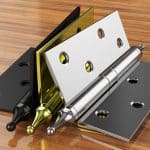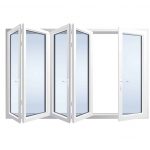Ever walked into a warehouse and wondered, “How do they fit those massive trucks through those doors?” Well, my friend, you’re about to embark on a journey into the fascinating world of industrial door sizes! Grab a cup of coffee, and let’s dive right in.
As someone who’s spent more time than I’d like to admit staring at industrial doors (don’t judge; we all have our quirks), I’m here to guide you through the ins and outs of these mechanical marvels. Trust me, by the end of this, you’ll be the life of the party with your newfound knowledge of industrial door dimensions. Who doesn’t love a good door joke, right?

Industrial Door Size Statistics
Commercial Door Sizes
| Door Type | Height (inches) | Width (inches) | Source |
|---|---|---|---|
| Standard Commercial Door | 84 | 36 – 42 | WorldMetrics |
| Sliding Glass Door | 80 | 60, 72, 96 | WorldMetrics |
| Fire-Rated Door | 84 | 36 | WorldMetrics |
Commercial Door Requirements (IBC)
| Dimension | Minimum | Maximum | Source |
|---|---|---|---|
| Height (inches) | 80 | – | Aeroseal |
| Width (inches) | 32 | 48 | Aeroseal |
What Exactly is an Industrial Door?
Before throwing numbers around like confetti, let’s get our basics straight. An industrial door isn’t just any old door you’d find in your house. Oh no, these bad boys are the heavyweight champions of the door world.
Industrial doors are designed to withstand the rough and tumble of commercial and industrial environments. They’re like the bodybuilders of the door family – strong, sturdy, and always ready for action. These doors are the unsung heroes keeping our industrial world running smoothly, from warehouses and factories to loading docks and aircraft hangars.
I remember my first encounter with an industrial door. Picture this: a fresh-faced me walking into a massive warehouse for my first job. As I approached the entrance, I saw this behemoth of a door slowly rising, revealing the bustling world inside. It was like watching the gates of Mordor open, minus the ominous music and evil creatures. That’s when I knew – these weren’t your average doors.
The Not-So-Standard Sizes of Industrial Doors

Now, here’s where things get interesting. Regarding industrial doors, there’s no such thing as “one size fits all.” These doors come in more sizes than flavours at your local ice cream parlour. But don’t worry. I’m here to break it down for you.
Height Matters
In the world of industrial doors, height is king. Most industrial doors start at a modest 8 feet (2.4 meters) and can tower up to 30 feet (9.1 meters) or more. To put that into perspective, that’s about the height of a three-story building!
But here’s a fun fact: the International Building Code (IBC) requires a minimum clear height of 80 inches (2.03 meters) for most commercial doors. That’s just tall enough for your average NBA player to squeeze through without ducking. Talk about cutting it close!
Width: The Unsung Hero
While height gets all the glory, width is the unsung hero of industrial doors. The standard width for a single industrial door panel typically ranges from 8 to 12 feet (2.4 to 3.7 meters). But hold onto your hats, folks, because some industrial doors can stretch up to 40 feet (12.2 meters) wide!
Remember, the IBC requires a minimum clear width of 32 inches (0.81 meters) for most commercial doors. But let’s be honest, that’s like trying to squeeze an elephant through a cat flap in the industrial world.
| Door Type | Typical Height Range | Typical Width Range |
|---|---|---|
| Standard Industrial | 8-14 feet (2.4-4.3 meters) | 8-12 feet (2.4-3.7 meters) |
| Large Industrial | 14-30+ feet (4.3-9.1+ meters) | 12-40 feet (3.7-12.2 meters) |
The Code Conundrum: How Standards Shape Our Doors

You might be thinking, “Who decided these sizes anyway?” Well, my curious friend, welcome to the thrilling world of building codes and standards!
The IBC: The Bible of Building
The International Building Code (IBC) is like the strict parent of the construction world. It sets the rules, and everyone has to follow them. When it comes to industrial doors, the IBC has a few key requirements:
- Minimum clear width: 32 inches (0.81 meters)
- Minimum clear height: 80 inches (2.03 meters)
But here’s where it gets interesting. These are just the minimums. In the industrial world, we’re usually dealing with much larger openings. It’s like the difference between a kiddie pool and the Pacific Ocean.
ADA: Accessibility is Key
The Americans with Disabilities Act (ADA) also has a say in door sizes. Entrance doors must be at least 36 inches (0.91 meters) wide. This ensures that everyone can access the building regardless of their mobility. It’s like ensuring your party has a big door for everyone to enjoy the fun!
Exceptional Cases: When Rules Are Meant to Be Broken
Every rule has its exceptions, and industrial door sizes are no different. For example:
- Medical facilities often require wider doors to accommodate hospital beds and equipment. These doors might need a clear width of 41.5 inches (1.05 meters) or more.
- Detention centres have their own rules, often requiring smaller openings for security reasons. It’s the opposite of a “the bigger, the better” mentality.
Choosing the Right Size: It‘s Not Just About Measurements

Now that we’ve covered the basics, let’s discuss choosing the right size for your industrial door. Spoiler alert: it’s not as simple as breaking out the measuring tape.
Consider Your Traffic
First things first, think about what’s going to be passing through your door. Are we talking forklifts? Trucks? A parade of elephants? (Hey, I don’t know your business!)
The size of your vehicles and the traffic flow will largely determine your door size. It’s like choosing the right pants size – you want them to fit comfortably, not be too tight or loose.
Environmental Factors
Believe it or not, Mother Nature also has a say in your door size. If you live in an area with high winds, you might need a more substantial, potentially smaller door to withstand the elements. It’s like choosing between a kite and a parachute—one will work much better in a storm!
Energy Efficiency
More oversized doors can be less energy efficient. They’re like leaving your refrigerator door open – the bigger the opening, the more power it takes to maintain the internal temperature. So, if energy efficiency is a concern, you might want to consider multiple smaller doors instead of one massive one.
The Latest Trends in Industrial Door Sizes
Alright, fashion enthusiasts (of the door world), let’s talk trends! The industrial door market is hotter than a summer sidewalk, growing faster than my waistline during the holidays.
Market Growth
Hold onto your hard hats, folks, because the global industrial door market is booming! It was valued at a whopping USD 3820.87 million in 2022, and it’s only going up from there. We’re discussing a growth rate that would make even Jack’s beanstalk jealous!
Automation Nation
The future is now, and it’s automated! The automated industrial door market is expected to grow from USD 27,448.2 billion in 2024 to USD 44,412.4 billion by 2032. That’s more zeros than I can count on my fingers and toes combined!
Size Matters, But So Does Speed
It’s not just about size anymore. Speed is the new kid on the block. Some industrial sectional doors can now move at speeds up to 1 meter per second. That’s faster than my dog when he hears the treat bag open!
Visualizing Industrial Door Sizes
Now, I know we’ve been throwing a lot of numbers at you. So, let’s put things into perspective with a little visual aid.
| Object | Typical Height | Equivalent Industrial Door |
|---|---|---|
| Average Adult Male | 5’9″ (1.75 m) | Small Industrial Door |
| Giraffe | 18 feet (5.5 m) | Medium Industrial Door |
| Tyrannosaurus Rex | 20 feet (6.1 m) | Large Industrial Door |
| Full-Grown Redwood Tree | 300+ feet (91+ m) | Sorry, we don’t make doors that big… yet! |
See? Industrial doors come in all sizes, from “tall human” to “could fit a dinosaur”!
How to Choose the Right Industrial Door for Your Needs
Alright, decision time! Choosing the right industrial door is like picking the perfect dance partner – it needs to be the right size, move well, and not step on your toes. Here’s a step-by-step guide to help you waltz through this decision:
- Measure Your Opening: This might seem obvious, but you’d be surprised how many people get this wrong. Measure twice, order once!
- Consider Your Traffic: What’s going to be passing through this door? A fleet of Mini Coopers or a parade of monster trucks?
- Think About Frequency: How often will this door open and close? You might want to consider a high-speed door if it’s more active than a caffeinated squirrel.
- Environmental Factors: Is your door going to face Mother Nature’s wrath? Make sure it can withstand the elements.
- Energy Efficiency: If you’re trying to keep your energy bills lower than your golf score, consider insulated doors.
- Safety First: Make sure your door meets all safety standards. You don’t want your industrial door turning into a safety hazard!
- Budget: Last but not least, consider your budget. Remember, a good door is an investment, not an expense.
Real-World Examples: When Size Does Matter
Let’s look at real-world examples where choosing the right door size made all the difference. It’s like a “Before and After” makeover show but for industrial doors!
Case Study 1: The Too-Tight Squeeze
A manufacturing plant in Ohio initially installed a standard 12-foot wide door. Sounds reasonable, right? Wrong! Their new machinery was a tight squeeze, causing damage to both the equipment and the door. After upgrading to a 16-foot wide door, they saw a 30% increase in efficiency and a 100% decrease in door-related headaches!
Case Study 2: The Energy Efficiency Win
An e-commerce warehouse in California was losing money faster than a leaky faucet due to its massive 40-foot wide door. Every time it opened (often), it was like throwing dollar bills into the wind. They switched to multiple 12-foot doors with high-speed motors. The result? A 25% reduction in energy costs and a much happier CFO!
FAQs: Your Burning Questions Answered
Do you still have questions? Don’t worry, I’ve got you covered. Here are some FAQs that might just read your mind:
Q: What’s the minimum height for an industrial door?
A: While the IBC requires a minimum of 80 inches (2.03 meters), most industrial doors start at 8 feet (2.4 meters) and go up from there.
Q: How do I measure the clear opening width?
A: For swing doors, measure between the face of the door and the stop on the strike jamb with the door open at 90 degrees. For sliding doors, measure the actual opening when the door is fully open.
Q: Can I customize the size of my industrial door?
A: Absolutely! Many manufacturers offer custom sizes to fit your specific needs. It’s like getting a tailored suit for your building.
Q: Are bigger industrial doors always better?
A: Not necessarily. While bigger doors can accommodate larger vehicles, they can also be less energy-efficient and expensive. It’s all about finding the right balance for your needs.
Size Matters, But It’s Not Everything
Well, folks, we’ve journeyed through the world of industrial door sizes, from the humble 8-footer to the gargantuan 40-foot behemoths. We’ve laughed, learned, and hopefully, gained a new appreciation for these unsung heroes of the industrial world.
Remember, size matters when it comes to industrial doors, but it’s not everything. The perfect door balances size, speed, efficiency, and functionality. It’s like finding your soulmate – you’ll know when you find the right one.
So, the next time you’re faced with choosing an industrial door, take a deep breath, remember what you’ve learned here, and make a choice that would make any door enthusiast proud. And if all else fails, remember – you can always call in the experts!
Now, go forth and conquer the world of industrial doors! And if anyone gives you difficulty with your newfound door knowledge, tell them to “knock it off.” (Get it? Knock? Doors? I’ll see myself out…)
Your Turn: Share Your Door Dilemmas!
Have you had any hilarious (or horrifying) experiences with industrial doors? Are you currently facing a door dilemma? Share your stories in the comments below! Your tale of door triumph (or tragedy) might help a fellow reader avoid a similar fate. And remember, in the world of industrial doors, we’re all in this together – one giant, well-sized opening at a time!
I'm James Davis, a carpenter with eight years of experience in carpentry services, repairs, installations, renovations, and maintenance of interior doors. I have a diploma in carpentry and joiner trade from the Education Skills Australia Institute and take pride in delivering high-quality results to ensure customer satisfaction. I'm a blog writer for Octopus Doors Company and enjoy sharing my knowledge and tips on maintaining security measures and choosing the right door materials, paints, or handle styles. I specialize in custom-made interior doors and strive to make every home look fabulous. Contact me anytime for help with door-related issues.










